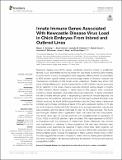Innate Immune Genes Associated With Newcastle Disease Virus Load in Chick Embryos From Inbred and Outbred Lines

View/
Date
2019-06-20Author
Schilling, Megan
Memari, Sahar
Cattadori, Isabella
Katani, Robab
Muhairwa, Amandus
Buza, Joram
Kapur, Vivek
Metadata
Show full item recordAbstract
Newcastle disease virus (NDV) causes substantial economic losses to smallholder farmers in low- and middle-income countries with high levels of morbidity and mortality in poultry flocks. Previous investigations have suggested differing levels of susceptibility to NDV between specific inbred lines and amongst breeds of chickens, however, the mechanisms contributing to this remain poorly understood. Studies have shown that some of these differences in levels of susceptibility to NDV infection may be accounted for by variability in the innate immune response amongst various breeds of poultry to NDV infection. Recent studies, in inbred Fayoumi and Leghorn lines, uncovered conserved, breed-dependent, and subline-dependent responses. To better understand the role of innate immune genes in engendering a protective immune response, we assessed the transcriptional responses to NDV of three highly outbred Tanzanian local chicken ecotypes, the Kuchi, the Morogoro Medium, and the Ching’wekwe. Hierarchical clustering and principal coordinate analysis of the gene expression profiles of 21-day old chick embryos infected with NDV clustered in an ecotype-dependent manner and was consistent with the relative viral loads for each of the three ecotypes. The Kuchi and Morogoro Medium exhibit significantly higher viral loads than the Ching’wekwe. The results show that the outbred ecotypes with increased levels of expression of CCL4, NOS2, and SOCS1 also had higher viral loads. The higher expression of SOCS1 is inconsistent with the expression in inbred lines. These differences may uncover new mechanisms or pathways in these populations that may have otherwise been overlooked when examining the response in highly inbred lines. Taken together, our findings provide insights on the specific conserved and differentially expressed innate immune-related genes involved the response of highly outbred chicken lines to NDV. This also suggests that several of the specific innate immunity related genes identified in the current investigation may serve as markers for the selection of chickens with reduced susceptibility to NDV.
